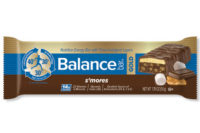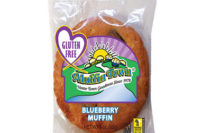With the continued focus by American consumers on healthy eating, childhood obesity and the rising diabetes rate, sweeteners have been in the spotlight, especially where baked goods and snack foods are concerned. The trend in healthy and natural foods has created more opportunities for the development of natural sweeteners in baking and snack foods.
Technology company zuChem Inc. in Chicago works with food manufacturers to develop new sweeteners. “Natural sweeteners are a big thing,” says David Demirjian, president and CEO. “Companies are trying to come up with new, natural, high-intensity low- and no-calorie sweeteners.”
In fact, more sugar-free sweeteners are available today than ever before, as are ingredients that enable food manufacturers to create cleaner labels. And, as new sweeteners emerge, consumers are becoming increasingly aware of how these ingredients are impacting not just their taste buds and waistlines, but also their overall health.
In the 2013 Food & Health Survey by the International Food Information Council Foundation, 68% of consumers polled said they consider sugars when deciding what packaged food or beverages to buy, while 56% and 53%, respectively, said they considered high fructose corn syrup and low-calorie sweeteners.
Much of the focus has been on producing low-sugar and sugar-free products for people with diabetes. “Bakers and snack producers are becoming more proactive in finding the right solution to create low-sugar, diabetic-safe baked snacks and uncooked snack/meal replacement bars,” says Thom King, president of Steviva Brands Inc., Portland, Ore. “And producers are more selective about the sweeteners they’re using. They want ingredients that target label-reading consumers who look for all-natural and nonGMO (genetically modified organism) [products].”
There has been good news on this front. A new review in the summer 2013 edition of the biannual medical journal, US Endocrinology, found that low-calorie sweeteners can be used to both help prevent and manage Type 2 diabetes. The study, “The Role of Low-calorie Sweeteners in Diabetes,” found that low-calorie sweeteners offer a practical method for promoting a reduction in caloric intake and can aid in weight and diabetes management.
It took Steviva Brands three years to develop Fructevia, a sweetener that provides caramelization and browning as well as a quality mouthfeel. “We weren’t convinced we had it dialed in at first, since we were running into separation issues after 60 days, so this ingredient was originally available on an on-demand basis,” King says. “But we saw the need for a sweetener to replace high fructose corn syrup, so we tweaked the formula, and it has received a solid reception.”
He adds that “people are addressing sugar reduction on a global basis. Consumers are seeking nonGMO products, and they want clean-label ingredients.”
Carlos Rionda, vice president of sales and marketing at Zucrum Foods LLC, Nogales, Ariz., concurs: “Consumers’ desire for nonGMO ingredients is the biggest topic of discussion. Research shows that 63% of consumers are looking to avoid GMO ingredients as much as possible.”
Impact of the trends
Sweetener innovations, however, have taken a hit from current poor economic conditions. As in many food segments, increasing commodity prices are affecting the bakery and snack food industries, causing greater pressure on manufacturer unit costs.
“Our customers are looking for ways to save on costs, whether formulation costs, processing improvements or ingredient cost reductions,” says Pat O’Brien, marketing manager, bakery, at Ingredion Inc., Westchester, Ill. “There also are concerns around health, obesity and nutrition by fortification or by reducing unwanted fat, sugar and caloric intake in products.”
With that in mind, Ingredion developed its Dial-In Sweetness program, a methodical approach that uses data, experience and understanding of the process to help its customers achieve their needed level of sweetness.
“Companies are looking at alternative sweeteners for cost savings,” echoes Nate Yates, business director for Enliten and North America Sweetness Innovation. “Primarily, there’s more of a health issue regarding alternative sweeteners, [with a focus on] lower caloric value to reduce sugar and calories.”
Depending on the product and company, the goal may be to produce either an artificial or natural sweetener as an ingredient for baked goods or snack foods, Yates explains. “We’ve seen a trend in the growth of natural sweeteners, such as Stevia, which has been increasing dramatically,” he says. “Much of this becomes an intricate dance in formulation, which is critical to achieving an end product that doesn’t sacrifice quality and taste.”
The forgotten sweetener
Manufacturers are seeking out Briess Malt & Ingredients Co.’s gluten-free BriesSweet Tapioca Syrups, according to the Chilton, Wis.-based company, and Briess has also introduced BriesSweet White Sorghum Syrup, which is made from the sorghum grain rather than the cane. “This product has full conversion, is lighter with a more mellow flavor and, unlike many other gluten-free sweeteners, it browns,” explains Judie Giebel, who is in charge of technical services at Briess.
Use of malt extracts is increasing, though some consider malt the forgotten sweetener, relegated to use as a brewing ingredient. “Malt is now used more for flavoring and coloring, especially with artisan baking,” Giebel says. “It offers a rich flavor that manufacturers can use to reduce the need for sugars.
“Tapioca and sorghums are also one-for-one replacements for conventional corn syrup. These come in different dextrose equivalents (DE), which makes them more versatile.” A DE of 28, for example, is adaptable for bar binding, while a DE of 63 provides more of a sweet flavor.
“As far as functionality or use, these sweeteners are the same, but are used more to clean up labels and conform to gluten-free product requirements,” Giebel adds.
By comparison, malt extracts have a 45 DE, contain no additives and have no use restrictions. Yet they require manufacturers to consider flavor and formulas, she notes. “Malt extracts will function close to glucose syrup, but are not high-intensity sweeteners,” Giebel explains. “More baked goods and snack food producers are trying to get away from high-intensity sweetness to retrain consumers’ palates and bring down obesity levels.”
Malt extracts can also reduce some of the sweetness in these products and be used in snack products with grill marks.
More sweetener options
In addition to Fructevia, Steviva produces Nectevia, a Stevia-fortified agave nectar that replaces high fructose corn syrup in cooking and baking processes. Four times as sweet as sugar, the product has less than three calories per g. It’s also GMO-free, shelf- and heat-stable and has a high solubility and low hygroscopicity (the ability to hold and absorb water from the air). Both Nectevia and Fructevia work well in cooking and baking, and are low in calories and safe for diabetics, according to the company.
Steviva’s new Steviva Blend 100 mesh fine powder is a plug-in solution for a zero-calorie replacement for confectionary sugar. “With today’s sweeteners, it’s all about ease of use, all-natural labeling, reduced sugar, calorie nutritional panels and extended product shelf life,” King says.
ADM Milling, Overland Park, Kan., offers Sweet N Neat 2000 Dry Honey Powder and Sweet N Neat 4000 Dry Molasses Powder. Its Honi-Bake Dry Honey Powder can be used in breads, cookies, cakes, snack foods, health foods and other products where that the natural flavor of honey is desired.
“Honey and molasses have broad consumer appeal as natural sweeteners and flavorings,” says Brook Carson, director of R&D at ADM Milling. “In food products, these ingredients provide many other essential attributes, such as color, aroma, browning, texture, improved moisture retention and extended keeping quality. Now, dry honey, molasses and malt can be used in applications where process or product constraints previously prevented the use of liquid honey and molasses.”
One of the main advantages of dry honey and molasses, ADM says, is their ease of use. Dry sweeteners that have been converted into a free flowing powder have a sugar-like granulation. ADM’s dry honey and molasses can be easily scaled when used in food applications. These products also are not impacted by cold or warm temperatures.
“Because these products are dry, they’re not affected by temperature, they can be used at room temperature, and they wouldn’t need to be heated like liquid honey or molasses before being used,” Carson says. “With a dry product, manufacturers can get all of the ingredients out of the container [more easily than with syrup-type sweeteners].”
With the increasing number of low-sugar and nonsugar products on the market, more manufacturers are examining their sweetener options. “Experience has shown that in formulas developed using liquid honey or molasses, we can replace the liquid sweetener, pound for pound, with dry honey and dry molasses,” Carson says. “In fact, it is very common to replace the liquid sweetener with dry sweetener at 10 to 20% and still have the same flavor and color in the finished application.”
Dry honey and dry molasses sweetener is added with the other dry ingredients to applications. There’s no need to pre-hydrate the dry sweetener beforehand either. When used in a dough or batter application, one-half to one pound of water can be added for every pound of sweetener used. It’s this additional water that can increase the yield of the finished product.
Points of distinction
There are points of differentiation with the many sugar substitutes now available. “Xylitol and Mannitol are both made chemically with sugar from birch trees or fructose from corn syrups,” zuChem’s Demirjian explains. “Chemical hydrogenation is performed to convert the sugar into polyols.”
Because this isn’t a natural process and involves chemicals, manufacturers continue to look for other ways to produce sweeteners that perform well in baked goods, snack foods and other products. “We are working with the U.S. Department of Agriculture (USDA) and the Department of Energy to develop natural processes to make such products,” Demirjian says.
For instance, zuChem Foods is using fermentation to grow and use organisms that can convert a sugar starting material into a sweetener. The product is a pure cane sugar, nonGMO ingredient that can be substituted for refined sugar on a one-to-one basis, according to the company. zuChem is also working on developing a cane sugar blend.
Direct replacements
Like many other ingredients, some sweeteners have limitations that bakers and snack manufacturers can consider. “Aspartame can have issues, since it’s one of the less stable artificial sweeteners when it’s used at high temperatures,” Yates says. “We are seeing interesting usage with agave, which has appeal since it’s natural, but, at the same time, it’s a full caloric sweetener that brings a different taste profile.”
Ingredion recently introduced DULCENT Aspartame, sucralose and Ace-K (acesulfame potassium) products, which provide functionality and sweetness profiles for a broad range of foods and beverages. Aspartame can be used to reduce or eliminate sugar and calories at a reduced cost. Sucralose is a baking ingredient, and Ace-K can be used in baking to blend sweeteners for cost advantages.
Technological benefits
New technology has created sweetener alternatives that are safe, natural and higher quality, Demirjian says. “Methods have been developed to produce natural sweeteners that are more cost effective than their chemical counterparts,” he explains.
Wixon, St. Francis, Wis., offers a taste modifier for Stevia that allows the sweetener’s flavor to build quicker and not linger. “With this modifier, producers don’t need to use as much Stevia in products,” says Mariano Gascon, Wixon’s vice president. “It’s heat- and baking-stable, so it can be used in any type of food application.”
Blending sweeteners together also has become more common. For example, polyols are blended with other products like Stevia to eliminate a bitter or lingering aftertaste, explains Demirjian. Sugar substitutes provide the same taste benefits of sugar, while offering manufacturers the qualities needed for baking.
“Our sweetener has a golden natural color, a nonGMO certification and can be used across the board,” Rionda says of Zulka pure cane sugar. “It is a one-to-one substitution for refined sugar that has a good mouthfeel and flavor. And because it retains more natural freshness of the cane, less of it is needed.”
“If a company doesn’t offer a sugar-free version, it’s typically offering a low-sugar alternative,” Giebel says. “This can be accomplished with high-intensity sweeteners that are more natural.”
To address the overall concern for obesity, snack food processors and bakers will continue looking for artificial sweeteners with less calories and sugar that cost less. “As sugar is reduced, a void is produced by high-intensity sweeteners,” Yates says. “There can’t be a deficit in bulk and mouthfeel, and texture is critical when looking at formulating with these substitutes, whether they’re natural or not.”
Thanks to today’s technology, bakers and snack manufacturers have a wide choice of sugar substitutes from which to choose that are easy and cost-effective to use, without sacrificing product taste or quality.








